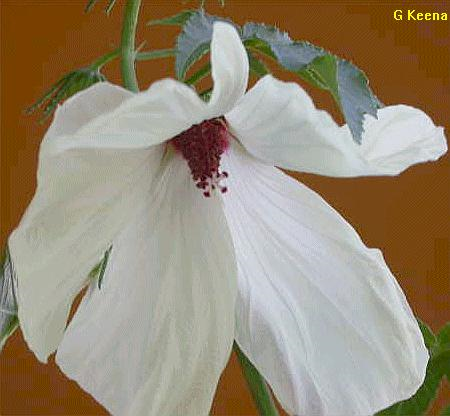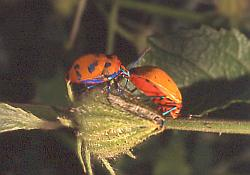General Description:
Hibiscus is a genus which is well known in horticulture through the many exotic species and cultivars, principally Hibiscus rosa-sinensis which has thousands of registered cultivars. Overall there are more than 300 Hibiscus species which occur mainly in tropical and sub-tropical regions. Australia has about 40 native species, most of which are endemic. There are also a number of closely related genera in Australia with Hibiscus-like flowers. These include Abelmoschus, Alyogyne, Gossypium, Howittia and Lagunaria.
Hibiscus meraukensis is a small to medium annual shrub up to about 2 metres in height. Plants appears during the tropical wet season and die off during the following dry season. The leaves are hairy when young and quite large, up to 180 mm long by 100 mm wide. The flowers are large, up to 100 mm in diameter of typical hibiscus shape and range in colour from white through to pink or mauve. In common with most Hibiscus species, the individual flowers last only 1-2 days but new flowers continue to open over a long period, generally in autumn. The flowers are followed by seed capsules containing a number of seeds.
H.meraukensis has received only limited cultivation and is not well known even among native plant enthusiasts. It is an attractive and quick growing species for tropical and sub-tropical climates and, although usually an annual, it can be readily propagated so that plants are always available in the garden. Its performance is untested in temperate areas but should perform well in a warm position such as against a brick or stone wall where heat is retained in the structure. It prefers full sun and moist, well drained soils.
Pests are generally few but, in common with the exotic cultivars, hibiscus beetles can be a problem. These can be controlled by placing white ice cream containers with detergent water among the hibiscus plants and putting fresh water and detergent in the containers every few days. Harlequin bugs may also be noticed and, although they draw sap from the plants, they are rarely a serious problem.
Propagation from seed is relatively easy and no special pretreatment is needed although germination will be faster if seed is abraded or soaked before planting. Cuttings also strike readily, particularly if cuttings are taken on an angle through a node and rooting hormone is applied to their ends.
For further information on Australian Malvaceae, see the Australian Native Hibiscus and Hibiscus-like Species website.
Thanks to Jim Purdie for the hint on using detergent water to trap hibiscus beetles.

Hibiscus meraukensis
Photo: Geoff Keena

Harlequin bugs
 Australian Native Plants Society (Australia)
Australian Native Plants Society (Australia)